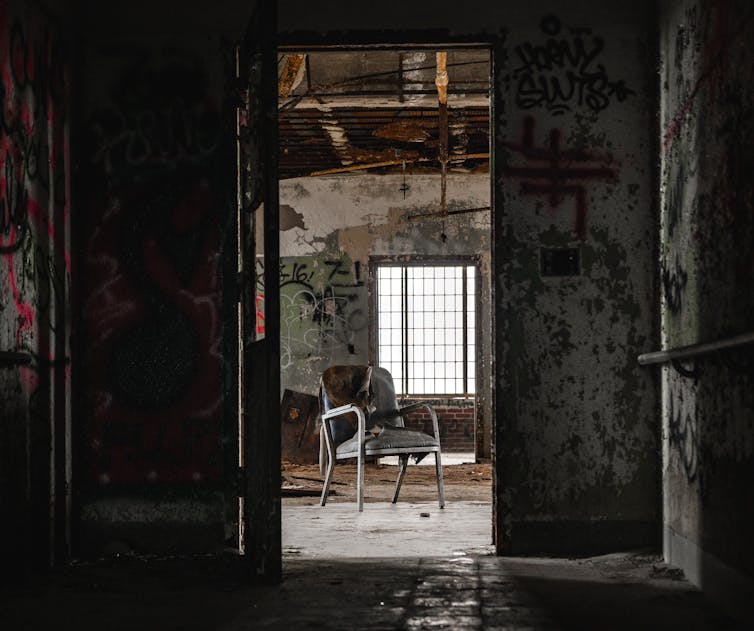You need only look to the UK’s high streets to see myriad buildings in decline. Walk through any city or town and witness the empty shops, vacant office blocks and derelict housing. A recent report from the Royal Society for Public Health revealed that one in 10 high street shops in the UK is empty.
Our research has found that people see value in derelict buildings that is often overlooked by policymakers, urban planners and property developers. The idea of economic value tends to dominate when dealing with buildings that require restoration, redevelopment and possibly demolition. But our work identified other ways that people value such buildings, that could prompt public policymakers to re-evaluate the role that empty or buildings play in society. As part of our research we talked to a number of people whose fascination with derelict buildings leads them to photograph these decaying relics.
This cultural interest is associated with the genre of “ruin porn” and has been highlighted in North American cities such as Detroit where deindustrialisation and economic instability have created a ruined landscape of once-fine civic buildings, their faded grandeur contrasting sharply with the bleak urban landscape.
Modern ruins rarely attract the same fascination, admiration or protection in comparison to recognised heritage sites. Often working-class heritage such as factories, mills and public transport hubs are overlooked in favour of castles, cathedrals and other sites of historical significance.
In drawing attention to neglected buildings through their photography, our interviewees counter this sense of waste, reject heritage prejudice and celebrate local culture. These people distinguish between old and new buildings and describe much of what is replacing the old as “homogeneous”, “devoid of any character” and “plain and uninteresting”.
‘Meanwhile’ projects
The negative impact of dereliction also creates “spatial stigma” where particular areas become associated with crime and social deprivation because of the number of abandoned buildings. But an alternative approach is to consider the value of derelict buildings for temporary use projects. Such “meanwhile” projects are environmentally sustainable as they enable buildings to be reused, decreasing the carbon, energy and water footprints created by demolition.

Temporary-use projects also have a economic impact by enabling businesses to use derelict buildings for short periods of time, often stimulating short-term economic growth and delaying demolition. For example, in Switzerland, Projekt Interim is an organisation that coordinates temporary rental and use of (temporarily) vacant property for business start-ups, pop-up shops and living accommodation.
These projects can also have a huge impact on local communities. The recent announcement that Clerkenwell fire station in London has been repurposed as a temporary homeless shelter demonstrates the benefits of reclaiming vacant space. Similarly, the Open Doors project is a new UK-wide government scheme in consultation with the Meanwhile Foundation that opens vacant high street spaces for meanwhile use by local community.
The Open Doors scheme encourages communities to be more creative when tackling the social and economic challenges they face, especially when it comes to young people. Gang violence in London, for example, has been partly attributed to the loss of community clubs and youth centres.
This repurposing of abandoned buildings for the good of the community resonated with the sentiments of one of our interviewees:
I always like the idea of places, like churches, being used for the community because that is why they were there in the first place. So if it can’t be a church, can it not be something for the local kids: youth clubs or something like that? That would be ideal for these places.
Such government schemes help to foster community ownership and pride in the local environment, encouraging people to get involved in the planning and decision-making that affects their lives. This could be supported by providing funding for community-led redevelopment. In Scotland, the Community Empowerment Act 2015 is a good example of how this could be achieved by reducing legal barriers for communities to reclaim disused buildings.

But temporary use is not always an option and often these buildings cannot be saved. In these cases, the wasting of buildings becomes a spectacle of prolonged ruination or demolition. A prime example is the Disappearing Glasgow project that documents the recent mass demolition of high-rise tower blocks in the city.
Neglected and unused buildings are ubiquitous in our surroundings and often go unnoticed, but they exist as a valuable resource, offering the potential for community projects and commercial opportunities that could enrich the lives of many.

